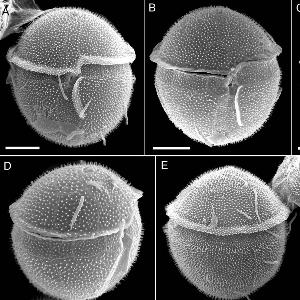Phytoplankton: The discovery of a missing link
17 Jun 2021
Biologists have identified a family of algae as a living missing link in the microscopic domain.
17 Jun 2021
Biologists have identified a family of algae as a living missing link in the microscopic domain.

Scanning electron micrographs of Fensomea setacea. Image: U. Tillmann, AWI/Bremerhaven
Over the course of evolutionary time, marine microorganisms have undergone an immense range of diversification. This applies in particular to the group known as dinophytes. Also known as dinoflagellates, these unicellular algae can account for a significant fraction of the phytoplankton in the oceans, and their ecological and economic significance is correspondingly high. A team of researchers led by LMU biologist Professor Marc Gottschling now reports the identification of a missing link between the two major phylogenetic groups of dinophytes, which sheds new light on the evolution of these organisms.
Many dinophytes are characterized by a bipartite protective structure called a theca, which consists of cellulosic plates synthesized in specialized vesicles that lie immediately below the plasma membrane. The patterning of the plates is often species- and group specific. In the new study, Gottschling and his colleagues focused on a monoclonal dinophyte strain that had been assigned to the Cladopyxidaceae. Using a combination of morphological analysis by electron microscopy and genetic characterization (by ribosomal RNA sequencing), they discovered – much to their surprise – that its phylogenetic position reveals it to be a ‘missing link’ between the two major groups of thecate dinophytes – the Gonyaulacales and the Peridiniales. In addition, the study showed that this dinophyte represents a new genus and species, which they named Fensomea setacea in honor of the micropaleontologist Robert A. Fensome.
“Missing links have made many important contributions to the understanding of evolution,” Gottschling points out. “Among the best known examples among macrofauna are the Urvogel Archaeopteryx and the coelacanth (Latimeria). But the recognition and documentation of a living missing link in the microscopic domain is also highly significant.” Up to now, the Cladopyxidaceae have been classified within the Gonyaulacales, while other Dinophyceae with a comparable hyposome were assigned to the Peridiniales.“Thanks to the recognition of this missing link, we have now shown that these are misaassignments,” says Gottschling. Based on our work the two large groups can now be morphologically defined in a more coherent manner, which clarifies their evolutionary history. The modern Cladopyxidaceae are most probably quite similar to the last common ancestor of all dinophytes, which originated about 200 million years ago. They are the last suvivors of a group that was much more abundant during the times of the dinosaurs.“
Publication: M. Gottschling et al.: Fensomea setacea, gen. & sp. nov. (Cladopyxidaceae, Dinophyceae), is neither gonyaulacoid nor peridinioid as inferred from morphological and molecular data. Scientific Reports 2021